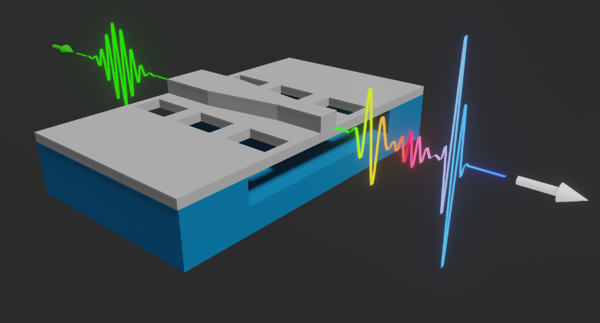Right after the invention of the laser, nonlinear optical effects were observed, with the first demonstration of second harmonic generation in 1961. This field opened fascinating and boundless new possibilities in optics. Research in nonlinear optics then grew and caught the attention of many scientists who discovered and studied new ways to play with light. In parallel, integrated optics rapidly demonstrated its capability to develop efficient and compact devices.
Thanks to the development of high performance and high-quality photonics platforms, it became possible to transpose the knowledge of nonlinear optical phenomena in free-space and bulk materials onto the field of integrated optics. In particular, frequency conversion has been under the spotlights for a long time as it finds itself very useful in many applications including frequency metrology, imaging, sensing, or optical communications to name a few examples.
Among the nonlinear optical processes, the generation of a supercontinuum light − i.e. the conversion of narrow-band pulsed laser light into a broadband continuum of light which spectrum can cover multiple octaves − is of first interest for many applications such as sensing, imaging and frequency metrology. Notably, an octave-spanning supercontinuum permits to use advanced interferometric techniques, such as f-to-2f interferometry, to reference and stabilize a frequency comb through carrier-envelope offset frequency detection.
More generally, a broadband coherent spectrum is a key to improve the performances of imaging systems, like optical coherence tomography, and of sensing techniques, such as dual-comb spectroscopy. Therefore, one of the challenges of supercontinuum generation (SCG) is its implementation on compact and low-cost platforms.
SCG arises from complex interplays of several effects, comprising nonlinear and linear optical behaviors. The physics of SCG has been widely studied, in particular in microstructured optical fibers as this technology permits to tailor the dispersion of light waves propagating along the fiber. Scientists then unraveled the complex nature of SCG, showing the existence of two different regimes, depending on the group velocity dispersion of the guiding structure and highlighting the intricate interplays between Kerr-type nonlinear effects and linear dispersion properties. Each regime has distinct signatures and different dynamics, that can be adapted according to the targeted application thanks to the flexibility of integrated photonics platforms.
The silicon photonics research group at the Centre de Nanoscience et de Nanotechnologie (C2N), CNRS, Université Paris-Saclay in France developed an expertise on SCG in several silicon-compatible photonics platforms, based on silicon, silicon nitride, silicon germanium and hybrid systems. Silicon-based materials present the great advantage to be compatible with fabrication techniques already in use in microelectronics, making it possible to manufacture efficient photonic circuits at high volume and low cost.
A review of SCG and its implementation in silicon photonics platforms is published in Photonics Research, Volume 10, Issue 3, 2022 (Christian Lafforgue, Miguel Montesinos-Ballester, Thi-Thuy-Duong Dinh, et al. Supercontinuum generation in silicon photonics platforms[J]. Photonics Research, 2022, 10(3): 03000A43).
This review paper gives an introduction to the physics and modeling of SCG in integrated waveguides, highlighting the role of dispersion engineering and of material properties. The choice of materials constituting the guiding structure determines the working wavelength range of the device. Silicon is generally used for mid-infrared operation up to 8 µm due to two photon absorption in the near-infrared region; germanium and silicon-germanium alloys are used to further extend the working wavelength range towards the mid-infrared region up to 14 µm due to the high transparency window of germanium; silicon nitride is generally used for generation in the visible and near-infrared windows thanks to its negligible to photon absorption in these ranges.
Then, the design of the waveguide plays a center role in SCG since it determines the dispersion properties of the device. In the normal dispersion regime, SCG is mainly governed by self-phase modulation and gives highly coherent and flat supercontinuum spectra. In the anomalous dispersion regime, SCG relies on soliton dynamics, creating broader spectra that are however more sensitive to perturbations.
In both cases, the progress in fabrication and design of silicon-based waveguides led to impressive progress in the field of integrated SCG. Many advanced demonstrations have been published, demonstrating high performance dual-comb spectroscopy, self-referenced frequency combs and multiple octave-spanning coherent SCG. The investigation of novel methods such as graded-index silicon-germanium alloys or suspended silicon waveguides for example show promising routes for mid-infrared SCG. Research on more complex dispersion-engineered waveguide also demonstrates exciting possibilities to improve coherence and flatness of supercontinuum spectra generated in the anomalous dispersion regime.
Additionally, the implementation of pulse compression stages on-chip and the rapid progress of integrated mode-locked lasers give good hope for compact SCG sources that could be a turning point for the development of optical communication systems based on frequency combs, for sensing or for quantum technology for example.

Figure 1. Schematic representation of SCG in a suspended waveguide with a varying width that provides more degrees of freedom for dispersion engineering. An optical pulse is sent in the waveguide and experiences soliton fission, creating several pulses with a broader spectrum.


